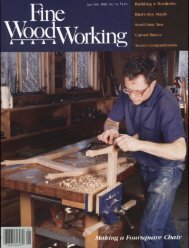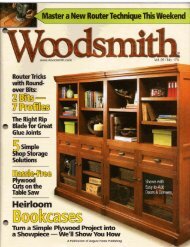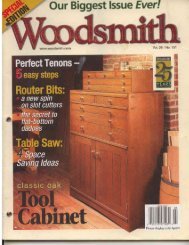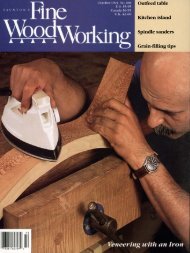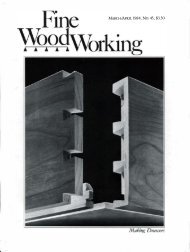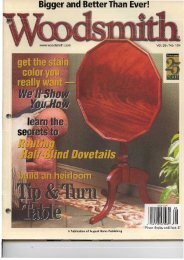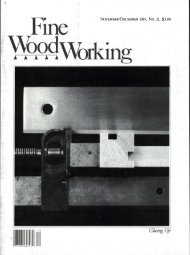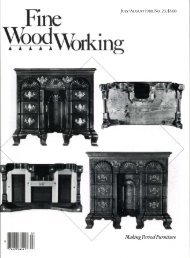Shaping with a Router - MetosExpo - Free
Shaping with a Router - MetosExpo - Free
Shaping with a Router - MetosExpo - Free
Create successful ePaper yourself
Turn your PDF publications into a flip-book with our unique Google optimized e-Paper software.
Methods of Work<br />
Drill-press milling machine<br />
<strong>Router</strong> bracket<br />
attached to<br />
drill-press column<br />
This method grew out of my need to make some small, precise<br />
wooden prototypes a few months back. First I purchased one of<br />
those XIY milling vises and clamped it to my drill-press table.<br />
Then I made a simple router bracket that locks onto my drillpress<br />
column. The permanently attached bracket, which swings<br />
out of the way for drilling, enables me to quickly and easily set<br />
up for milling whenever I need to.<br />
For the bracket, I chose phenolic for the baseplate because<br />
of its flaU1ess and rigidity and 2-in.-thick hardwood for the<br />
arms. I made the hardwood arms first and clamped them to<br />
the column <strong>with</strong> threaded rod. Then I screwed the baseplate<br />
to the anns.<br />
To use the milling machine, I first make a crude height adjustment<br />
between the vise and router by moving the drill-press table<br />
up or down, and dlen I make precise adjustments <strong>with</strong> the<br />
router itself. For quick router attachment and removal, I purchased<br />
an exu'a router base that I keep screwed to dle jig.<br />
-Micbael ]. McGinnis, Santa Rosa, Cal.<br />
edited and drawn by Jim Richey<br />
manent marking pens to help me remember which bit/edge I<br />
am using. To make tile base, I cut the Lexan slightly oversize,<br />
and then, after mounting the router and making test cuts, I ran<br />
the base over a jointer to carefully trim each edge to the exact<br />
offset needed.<br />
-Derek Roff, Albuquerque, NM.<br />
<strong>Router</strong> base for grooving in two passes<br />
Recently, I needed to cut a large number of %-in. grooves across<br />
several large pieces. Because I dislike using cutters larger dlall<br />
Y2 in. in my small router and because I wanted to minimize dle<br />
number of router-fence setups, I quickly designed alld cut dle<br />
asymmetrical router-base plate shown in dle drawing.<br />
The theory is quite simple. Simply valY the base's offset by the<br />
amount you want to enlarge the groove. In my case, I wanted to<br />
enlarge the Y2-in. groove to % in. So I cut the base 3 '12 in. from<br />
the center of dle bit on one side alld 3% in. on the other, a<br />
difference of Ys in.<br />
To use the fixture, set a fence parallel to the line of cut,<br />
make one pass <strong>with</strong> the first edge against tile fence, and then<br />
make another pass <strong>with</strong> the second edge against the fence.<br />
One setup, two passes, one odd-size cut.<br />
-Allen Trivino, Rocbester, NY<br />
Quick tip: Measuring tablesaw-blade height for a dado or<br />
groove cut can be a problem, especially if the blade insert is<br />
not exactly level <strong>with</strong> the tabletop. Instead, mark the desired<br />
height on the face of a scrap board that is longer than the<br />
insert, and clalllP the board to the fence flush on the table<br />
<strong>with</strong> the mark centered over dle blade opening. Lower dle<br />
blade and pOSition the fence so dlat when the blade is raised,<br />
it will skim the face of the scrap. Turn on the saw and raise the<br />
blade until it just touches the line.<br />
-Dal'io Biagiarelli, Kirkville, NY<br />
Improved radial-arm saw miters<br />
EDITOR'S NOTE: The following two methods describe ways to use an asymmeu'ical<br />
router base to solve different setup problems.<br />
Asymmetrical router base simplifies setups<br />
RoWs router base<br />
. .' < t ;eters 1/.2. .<br />
§<br />
$"t:;;;o"<br />
•<br />
, y<br />
_.. . I ,<br />
3<br />
\. _ ._ 3<br />
3 .<br />
<br />
I, <br />
-vi, .<br />
:<br />
Trivino's router base<br />
f '<br />
Offset for cutti ng %-in.-wide groove<br />
<strong>with</strong> 'h-in.-dia. bit<br />
.. ' " . ' " ..... .<br />
This edge for - '.<br />
first pass<br />
.. : _ . .'<br />
®- .- .<br />
3'12 --<br />
3%.<br />
I used to get frustrated <strong>with</strong> the inordinate amount of time it<br />
took to set up my router for even the simplest cuts. The main<br />
problem was that the distance from dle edge of the router base<br />
to the bit was always some weird dimension like 2'%2 in. So<br />
recendy, while making some new custom router bases out of<br />
Lexan, I got an idea. I cut the rectangular base so that each edge<br />
of dle router base will be exactly 3 in. from the edge of one of<br />
my standard bits. For example, if I am using a k in. bit, the edge<br />
marked Y4 in. will be exactly 3 in. from dle edge of dle bit. I also<br />
made one edge 3 in. from dle center of the bit, which is frequently<br />
useful (see the drawing, above left). In addition to writing<br />
dle bit size on each edge, I color-coded the edges witil per-<br />
"<br />
In "Medl0ds of Work," FWW #86, Steven Springston describes<br />
a method of sawing picture-frame miters using complementary<br />
angles. Although Mr. Springston's method will produce a<br />
perfect 90° angle, if the saw's 45° setting is off much, the technique<br />
may produce miters <strong>with</strong> faces that don't match. This<br />
problem can be especially troublesome on highly detailed<br />
moldings. By contrast, my method, illustrated above, uses the<br />
actual cut line of the blade for its registration and avoids the<br />
mismatch problem.<br />
Ciall1P all auxilialY table on the main sawtable, alld cut a 'Is·in.<br />
deep sawkerf into tile table. Into ti1is kerf insert a 'I4 -in.-wide strip<br />
of '/s-in.-dlick hardboard to act as a temporary setup fence. Place<br />
a 45° drafting U'iallgle against tile fence, alld use it to set dle<br />
position of the left-side fence. Screw the fence to the table so it<br />
overlaps the kerf a bit; it will be trimmed later. Flip the triangle<br />
to the opposite side of dle hardboard, and repeat the procedure<br />
described for tile right-Side fe nce, as shown in the drawing.<br />
14 Fine Woodworking



